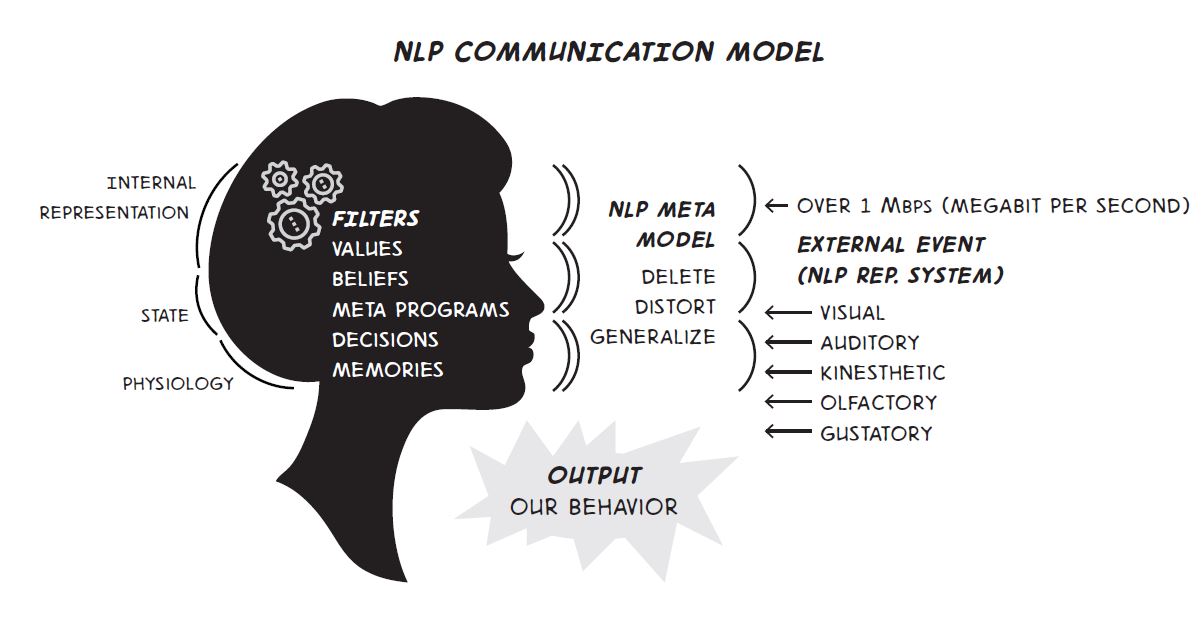
Isn’t it amazing how the human brain can be so powerful? You can even rewire it to achieve things you didn’t know you were capable of.
Before I understood how my mind works, I used to believe that events from my past will always have an influence on what I will become in the future. I thought I couldn’t possibly change my behaviors, especially when those behaviors were instilled in me since I was a child.
But when I discovered that it’s possible for our brains to create new pathways, I recognized how powerful it is and how this can improve a person’s behavior, health, and mindset. Keep reading for an in-depth understanding of how our minds work!
What Is NLP or Neuro-Linguistic Programming?
From the name itself, it basically means organizing and understanding the language of the brain. It involves taking control of both the conscious and subconscious mind to change one’s behavior and thoughts.
The practice of NLP started in the 1970s as a treatment for schizophrenia, phobias, depression—even allergies and flu. It is also used to help improve one’s work performance and discover how one perceives happiness. So, how does it work?
There are different tools and techniques in NLP that are used to control how we see negative things from our past and change our perception of them. As an example, if someone has hurt me with their words before, distorting their voice and how they said it may make me perceive the words in a more comical way.
Now, I’m going to compare NLP to the so-called ‘placebo effect’, also called the power of belief. If I strongly believe that I won’t live a long life, chances are I will really die young. But if I put my mind to outliving my grandmother, then there’s a higher chance I will do so.
Now, I will compare that to neuro-linguistic programming. In contrast to the placebo effect, NLP is about setting goals for ourselves. It is the power to control beliefs and visualize them in other ways. It also focuses on asking and answering the right questions—so, If I want to outlive my grandmother, I need to ask myself, “How can I outlive her?”
NLP is about having the right communication with our subconscious, which is believed to be more powerful than our conscious mind. NLP helps with sending the right messages to our subconscious so that it can interpret our goals better and understand what we want in life.
There are a number of studies that prove NLP works in treatments. In a study done by Structured Clinical Interview for DSM‐IV Personality Disorders (SCID II), a therapy group who underwent NLP had a significant decrease in clinical illness and an increase in their quality of life as opposed to those who hadn’t.
Understanding NLP presuppositions can increase your awareness and make you a better leader of yourself and others.
Neural Pathways
Another way we can change our behaviors and thoughts is by understanding how our brain works. The human brain is composed of thousands of neurons that are connected by dendrites. When we develop a new habit, these dendrites increase in number and form new connections in our brain.
These connections are called neural pathways. I sometimes think of it as a road—if I do something for the first time, the neural pathway is like an unpaved road. The more I repeat the task, the more it’ll turn into a habit. And when that becomes a habit, the neural pathway will finally be a paved road, much like a highway—strong and well-formed.
For every discovery I’ve had ever since I was a child, a neural pathway has been formed in my brain. When I saw a bike for the first time, a connection in my brain suddenly began to take form. When I first rode it and practiced with it, that connection slowly became thicker. And when I finally learned it, the neural pathways became dominant—the transmission of connection has gotten faster and stronger. Because of this habit, I was able to ride a bike on auto-pilot.
Repeat. Repeat. Repeat Until It’s a Habit
Repeating the same actions or behaviors for at least three months or more helps develop a habit. However, that usually depends on the person. Not only that, it usually takes at least 10,000 repetitions to make a strong neural pathway. Similar to that, the more we think about something, the more our brains will make a dominant pathway of that thought in our brain.
Now, I’m going to get back to my bike riding skills. If I suddenly decided to stop learning it, that connection or neural pathway that formed in my brain would slowly deteriorate and eventually disconnect.
How Do Neural Pathways Affect Our Behavior?
As a kid, many of us grew up afraid of certain animals. We had an unnerving fear that somehow they would hurt us because that’s what some parents told us, right? That is why many people are still wary of adopting animals because of the pathway of fear that has formed in our minds.
Now, I will take that example and turn it into a good one. If I grew up believing that I am good at English, my brain will form a connection that associates me being good with words and in terms of communication. That connection will get stronger and stronger, creating a positive impact on me as an adult.
To put it simply, these connections influence our behaviors. The stronger the connection is, the more difficult it will be for us to change. The inability to change a pathway can lead to compulsive obsession and even addiction.
How Do We Turn Weak Neural Pathways Into Strong Ones?
Creating a new habit can be difficult, as it is part of human nature to focus on the negatives.
“I can’t do it.”
“I am too old for this.”
“How can I possibly change when I’ve been doing this for so long?”
However, there are tips and tricks on how to easily form new behaviors and change the perspective of the mind. Here are some:
- Be mindful and take in all the good things. Don’t rush it; habits take time to build, so just enjoy the process.
- Think of the positive emotions that are connected with a new habit. For example, a new habit in baking can be associated with a grandmother who also enjoys the same activity.
- Thinking of the future outcome helps the mind build willpower, reinforcing the habit. If a new habit is associated with fitness, think of the physical changes and the positive effects that it will have on the body.
- Repeat it until it becomes a habit. The key here is to create new neural pathways that will be strong enough to turn into superhighways.
Neuroplasticity
It is possible to change our neural pathways by changing how we perceive things through neuroplasticity. In fact, we can consciously change by reorganizing our own thoughts. We think of our old thoughts and ideas—for example, being scared of the animals before—and turn them into positive notes. “Well, these animals are so cute and fluffy after all. And they won’t hurt me as long as I respect their space.”
So, when it comes to bad habits or the ‘ruts’ in our superhighways, how do we turn them into new habits? The first key to this is consistency and practice.
For example, a student who’s not so good at math has a bad habit of not turning in her assignments. However, with consistent practice and assistance from her teacher, her brain has reordered her perception of math, and her brain has created a superhighway, one stronger than the pathway of her bad habit.
With her new and developed habit, the old one becomes a choice—an option that she can opt to live without. And once the brain has chosen to use the superhighway because it’s stronger, the old pathways will turn into rubble.
The second key is commitment. Here’s another example.
Smoking is a bad habit. However, a chain-smoker feels a certain sense of happiness whenever they smoke a cigarette. For this reason, they find it hard to leave old habits and start with new ones.
As much as consistency and practice are important, it’s also necessary to start. By start, I mean create a pathway—even just a small one—in the brain that can eventually turn into a superhighway. It’s hard to create new habits, but commitment needs to start somewhere. There are many things our brain can accomplish once we’ve committed.
Final Thoughts
It can be challenging to put an end to our ruts and change them into superhighways. However, once we’ve fully accepted and embraced the power of our mind, we can unleash its optimum potential to improve our goals and personal life.

 Being an effective leader requires many things. Aside from understanding our own skills and capabilities, we need to exert time and effort to understand what others can do and how factors in the environment affect our ability to lead. We need to look at the bigger picture and change our perspective on things.
Being an effective leader requires many things. Aside from understanding our own skills and capabilities, we need to exert time and effort to understand what others can do and how factors in the environment affect our ability to lead. We need to look at the bigger picture and change our perspective on things. The unpredictability of life is one of the reasons why living it can be very exciting. We never know what will happen next.
The unpredictability of life is one of the reasons why living it can be very exciting. We never know what will happen next.
